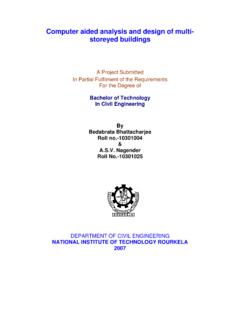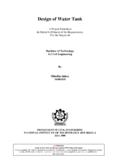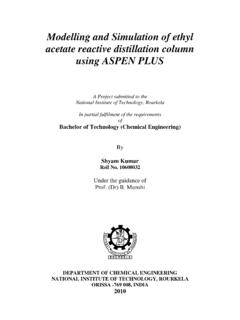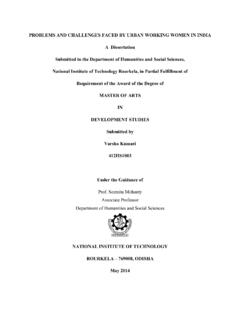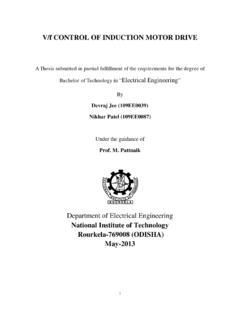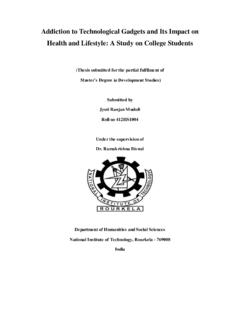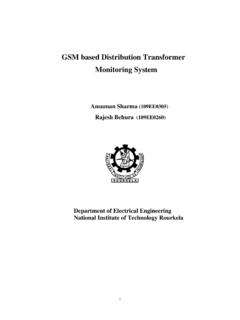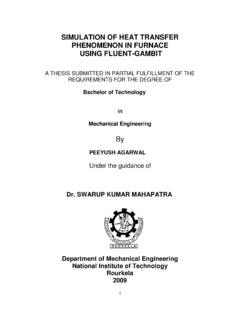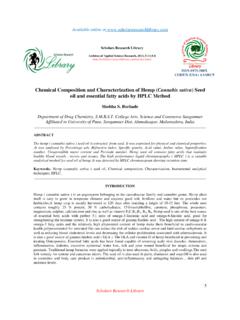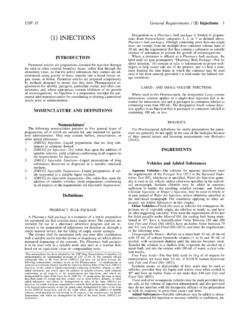Transcription of Preparation of Soap Using Different Types of Oils and ...
1 Preparation of Soap Using Different Types of Oils and Exploring its Properties Submitted by Debesh Mishra (109ch0476) Department of Chemical Engineering National Institute of Technology Under the guidance of Dr. Susmita Mishra ACKNOWLEDGMENT First and the foremost, I would like to offer my sincere gratitude to my supervisor, Dr. Susmita Mishra for her immense interest and enthusiasm on the project. She was always accessible and worked for hours with me. She was always kind and generous to me and lend me a helping at all stages of my project.
2 She has been a constant source of encouragement for me. I would also like to thank Dr. RK Singh and Dr. HM Jena for the wonderful support they gave to me. I would also like to appreciate the efforts put in by my friends during various stages of my thesis Preparation . I would also like to thank all technical assistants in our department for their constant help. Last but not the least, I wish to profoundly acknowledge my parents for their constant support. Debesh Mishra 109ch0476 ABSTRACT Soaps are the sodium salts or potassium salts of stearic acids or any other fatty acids.
3 They are prepared by the saponification process, which is, reacting the oil which contain triglycerides with caustic soda (NaOH) to give the soap. However Different oils have Different composition of fatty acids which are responsible for Different properties of soaps made out of them. In the present work 5 Different Types of oils are taken. They are blended in various ratios to prepare 14 Different samples of soap. Different properties of these samples were analyzed to see which soap is the best one. The cleansing and lathering properties of all samples were compared. The blend of coconut oil and castor oil at 3:1 ratio is found out to be the best with of TFM and of yield.
4 The best blend is analyzed for various properties and they were compared with that given in the literature. The saponification values, iodine values of coconut oil and castor oil were found out and these values were also found for the blend. It was found that the blend was having SAP value of and iodine value of 40 which are higher than the individual values. Thus soap prepared Using blend of both these oils has better properties than the soaps prepared by individual oils. CONTENTS Subject Certificate Acknowledgement Abstract List of Tables Chapter 1 Introduction
5 1 Chapter 2 Literature Review 3 Semi Boiled Process 3 Full Boiled 4 Cold Process 5 Different Types of soap making oils 7 Castor Oil 9 Olive Oil 10 Neem Oil 11 Coconut Oil 12 Chapter 3 Materials and Methods 13 Materials Required 13 Methodology 15 Preparation of Soap 16 Comparing Different properties of soap with detergent 17 Blending
6 Of Oils 18 Calculation of TFM 19 Calculation of free alkali 20 Analysis of the best blend 20 saponification value 20 Iodine value 21 Unsaponifiable Matter 22 Acid value 22 Chapter 4 Results and Discussion 23 Comparison of soap and detergent 23 Properties of soap after blending of oils 24
7 TFM values of soaps 27 Analysis of the best blend 27 saponification Values 28 Iodine Values 28 Unsaponifiable Matter 29 Acid value 30 Chapter 5 Conclusion 31 Chapter 6 References 31 List of Tables Name of the table Page no.
8 1 Composition of coconut oil 13 2 Yield of soap Using individual oils 23 3 Properties of soap versus detergent 23 4 Moisture and Hardness of soap samples from individual oils 24 5 Yield and pH values of soap samples from blending of oils 24 6 Lathering and cleansing power of soap samples from blending of oils 25 7 Moisture and Hardness of soap samples from blending of oils 26 8 Total fatty matter of best blends of oils 27 9 saponification value of the oil blend 28 10 Iodine value of the oil blend 28 11 Unsaponifiable matter 29 12 Acid value of the oil blend 30 1 Introduction: A soap is a salt of a compound, known as a fatty acid. A soap molecule has a long hydrocarbon chain with a carboxylic acid group on one end, which has ionic bond with metal ion, usually sodium or potassium.
9 The hydrocarbon end is non polar which is highly soluble in non polar substances and the ionic end is soluble in water. The structure of the soap molecule is represented below: The cleaning action of soapsbecause of their ability to emulsify or disperse water-insoluble materials and hold them in the suspension of water. This ability is seen from the molecular structure of soaps. When soap is added to water that contains oil or other water-insoluble materials, the soap or detergent molecules surround the oil droplets. The oil is, dissolved in the alkyl groups of the soap molecules while the ionic end allows it to be dissolved in water.
10 As a result, the oil droplets are to be dispersed throughout the water and can be washed away. A number of things affect the soap-making process and the quality of this soap produced. The characteristics of this soap depend on the quality of oil, and the amounts of the caustic soda and water used to make it. The speed of the reaction between the oil and the caustic soda is influenced by free fatty acid content of the oil, the heat of the components before mixing, and how vigorously the mixing is to be done. Free fatty acid contents, vigorous mixing, and heat, speed up the given soap-making process. Castile soap: a mild soap originally made in Spain with pure olive oil.
